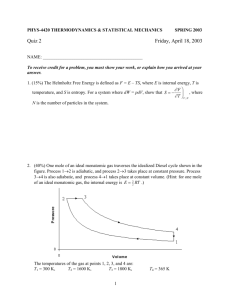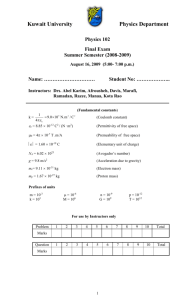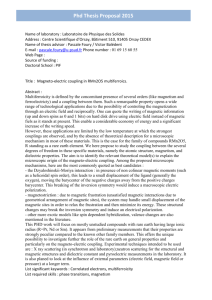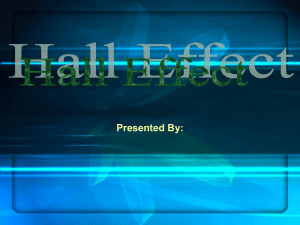Physics 12 Unit: Electromagnetism
advertisement
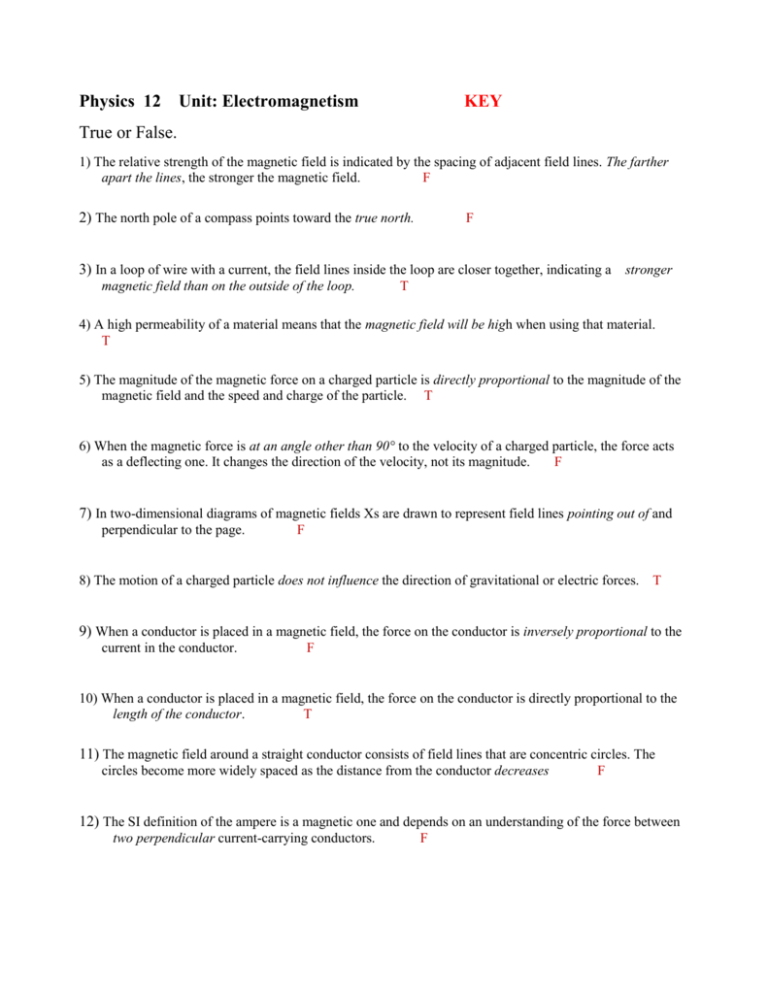
Physics 12 Unit: Electromagnetism KEY True or False. 1) The relative strength of the magnetic field is indicated by the spacing of adjacent field lines. The farther apart the lines, the stronger the magnetic field. F 2) The north pole of a compass points toward the true north. F 3) In a loop of wire with a current, the field lines inside the loop are closer together, indicating a stronger magnetic field than on the outside of the loop. T 4) A high permeability of a material means that the magnetic field will be high when using that material. T 5) The magnitude of the magnetic force on a charged particle is directly proportional to the magnitude of the magnetic field and the speed and charge of the particle. T 6) When the magnetic force is at an angle other than 90° to the velocity of a charged particle, the force acts as a deflecting one. It changes the direction of the velocity, not its magnitude. F 7) In two-dimensional diagrams of magnetic fields Xs are drawn to represent field lines pointing out of and perpendicular to the page. F 8) The motion of a charged particle does not influence the direction of gravitational or electric forces. T 9) When a conductor is placed in a magnetic field, the force on the conductor is inversely proportional to the current in the conductor. F 10) When a conductor is placed in a magnetic field, the force on the conductor is directly proportional to the length of the conductor. T 11) The magnetic field around a straight conductor consists of field lines that are concentric circles. The circles become more widely spaced as the distance from the conductor decreases F 12) The SI definition of the ampere is a magnetic one and depends on an understanding of the force between two perpendicular current-carrying conductors. F 13) When the current is constant in the primary coil of an induction apparatus, then a current is induced in the secondary coil. F 14) A larger current is produced when a magnet is plunged into a solenoid by increasing the number of turns in the coil. T 15) A larger current is produced when a magnet is plunged into a solenoid by using a stronger magnet. T 1) Which of the following statements about determining the magnetic field around a straight conductor is NOT correct? A) B) C) D) E) The thumb of your right hand that points is pointing in the direction of the current. A compass may be used when it is orientated perpendicular to the conductor. Grasp the conductor with your right hand. Curl the fingers of your right hand in the direction of the magnetic field lines. A compass may be used when it is orientated parallel to the conductor. 2) Which of the following statements about the loop shown below is false? (The loop is horizontally oriented.) A) The north pole of the loop is at the bottom of the loop labeled Z. B) The direction of the magnetic field cannot be determined. C) The magnetic field goes up through the loop. D) The magnetic field is strongest in the inside of the loop. E) The south pole of the loop is labeled X. 3) Which of the following statements for a solenoid is NOT true? A) B) C) D) E) To determine the magnetic field you grasp the coil in your right hand. A solenoid consists of a coiled conductor. Your right-hand thumb must be pointed in the direction of the south pole. The fingers of your right hand are curled in the direction of the electric current. The right hand rule for a solenoid is consistent with the right hand rule for a straight conductor. 4) Which of the following does NOT increase the strength of the magnetic field of a solenoid? A) B) C) D) E) triple the current double the number of loops double the core’s relative magnetic permeability use a paramagnetic material in the core instead of cobalt or nickel use soft iron for the core material instead of air 5) Which one of the following substances has the highest relative magnetic permeability? A) air B) steel C) copper D) aluminum E) water 6) The direction of a magnetic field is from right to left as shown below. A proton travels into and perpendicular to the plane of the page. The direction of the magnetic force acting on the proton is A) down B) up C) right D) left E) directly out of the page and perpendicular to the paper 7) In his experiment, J.J. Thomson demonstrated that cathode rays are deflected by a magnetic field. From this, we know that cathode rays A) contain potential energy B) travel in straight lines C) travel at the speed of light D) carry a charge D) are affected by the force of gravity 8) A magnetic force causes a positively charged particle q to undergo uniform circular motion in a uniform magnetic field B. The radius of the circular motion is r. The magnitude of the positively charged particle’s velocity can be described by which of the following? A) B) C) D) E) 9) The direction of the positively charged particle’s velocity according to the diagram above must be A) B) C) D) E) to the left to the right upward out of the page, perpendicular to the page into the page, perpendicular to the page 10) Which of the following statements are true about a magnetic force and field? I. A charged particle may travel through a magnetic field without experiencing a magnetic force. II. The magnetic field of a current-carrying conductor points toward the conductor. III. If you increase the magnetic field, then you increase the kinetic energy of the charged particle travelling through the magnetic field. A) I only E) III only B) I and II only C) I and III D) II and III only 11) Given that in the diagram below, B is the magnetic field and v is the speed of the positive particle, what is the direction of the magnetic force? A) right B) out of the page C) left D) into the page E) downward 12) A positively charged particle of mass 3.0 10–12 kg and charge +6.4 10–5 C is perpendicular to a 1.5-T magnetic field. If the particle has a speed of 4.8 103 m/s, the acceleration of this particle is A) 3.4 10–4 m/s2 B) 2.6 10–20 m/s2 D) 1.5 10–4 m/s2 E) 1.7 1019 m/s2 C) 1.5 1011 m/s2 13) A proton of charge 1.6 10–19 C is moving east with a speed of 8.2 107 m/s, as it enters a magnetic field of 2.5 T directed into the page. The magnitude and direction of the magnetic force acting on the proton is A) 3.3 10–11 N [N] B) 1.9 1011 N [S] D) 3.3 10–11 N [S] E) 1.9 1011 N [N] C) 5.3 10–12 N [S] 14) A 5.0-cm straight conductor carries a current of 12 A through a uniform 0.85-T magnetic field. When the angle between the current and the magnetic field is 25°, the magnitude of the force on the conductor is A) 120 N B) 0.22 N C) 86 N D) 0.86 N E) 22 N 15) A 50.0-cm straight conductor carries a current of 10.0 A through a uniform 0.55-T magnetic field. When the angle between the current and the magnetic field is 80.0°, the magnitude of the force on the conductor is A) 270 N B) 280 N C) 11 N D) 2.7 N E) 2.8 N 16) A 50.0-cm straight conductor carries a current of 10.0 A through a uniform 0.70-T magnetic field. When the magnitude of the force on the conductor is 0.5 N, the angle between the current and the magnetic field is A) 8.2° B) 0.036° C) 2.1° D) 35° E) 0.14° 17) A 50.0-cm straight conductor carries a current of 10.0 A through a uniform magnetic field. The magnitude of the force on the conductor is 0.50 N. The angle between the current and the magnetic field is 50.0°. What is the magnitude of the magnetic field? A) 1.9 T B) 190 N C) 0.13 T D) 12 000 T E) 120 T 18) A straight conductor carries a current of 15.0 A through a uniform 0.800-T magnetic field. When the magnitude of the force on the conductor is 0.426 N and the angle between the current and the magnetic field is 35.0°, what is the length of the conductor? A) 0.0619 m B) 986 m C) 0.0152 m D) 16.2 m E) 25.2 m 19) A conductor is located between the poles of a horseshoe magnet. Current flows in the direction indicated by the arrow on the diagram. In which direction will the conductor move? A) upward B) left C) downward D) right E) out of the page 20) What is the magnitude of the magnetic field 4.5 cm from a long, straight conductor carrying a current of 6.3 A? A) 8.9 10–6 T B) 2.9 10–9 T D) 2.8 101 T E) 2.8 10–1 T C) 2.8 10–5 T 21) The magnitude of the magnetic field 1.0 m from a long, straight conductor is 5.47 10–5 T. The current flowing through the wire must be A) 2.7 102 A B) 4.3 10–10 A D) 1.8 104 A E) 5.5 10–5 A C) 1.1 10–11 A 22) At what distance from a straight conductor, carrying a current of 6.0 A, is the magnitude of the magnetic field 4.6 10–4 T? A) 2.8 10–3 m B) 7.7 10–5 m D) 2.1 103 m E) 2.6 10–-3 m C) 3.8 102 m 23) What is the magnitude of the magnetic field in the core of a 10.0 cm long solenoid with 200 turns, carrying a current of 5.00 A? A) 1.00 102 T B) 1.00 104 T D) 5.03 10–6 T E) 1.26 10–2 T C) 7.96 107 T 24) What is the current flowing through a 4.0 cm long solenoid with 150 turns and a magnetic field of 3.6 10–3 T in its core? A) 2.2 100 A B) 7.6 10–1 A D) 1.3 100 A E) 4.8 102 A C) 2.2 10–2 A 25) How many turns are required in a 10.5 cm long solenoid with 3.5 A flowing through it to generate a magnetic field of 9.5 10–4 T in its core? A) 2.8 104 B) 3.1 1010 D) 4.9 1010 E) 4.9 101 C) 2.3 101 26) What is the length of a solenoid with 250 turns and 7.5 A flowing through it, having a magnetic field of 2.6 10–3 T in its core? A) 1.1 100 m B) 1.1 100 m C) 4.9 100 m D) 9.1 10–1 m E) 4.9 10–1 m 27) What is the magnetic field at point Y halfway between the two conductors in the diagram below? A) zero C) , out of the page E) , into the page B) , out of the page D) , into the page 28) What will happen in the following diagram showing two current-carrying conductors? A) B) C) D) E) The conductors will attract one another. The conductors will both move upward. The conductors will repel one another. The conductors will both move downward. Nothing will happen. 29) A permanent magnet is held still in the centre of a coil connected to a galvanometer. The galvanometer needle will A) steadily increase B) steadily decrease C) be steady and have a nonzero value D) steadily decrease and then increase E) be steady and have a zero reading 30) In the diagram below, a permanent magnet is pulled upward through a horizontal loop of wire. Which of the following describes the induced current as viewed from above? A) clockwise then counterclockwise B) clockwise C) counterclockwise then clockwise D) counterclockwise E) No current is induced. 31) An electron accelerates from rest through an electric field and into a magnetic field as shown in the diagram below. The plates have a potential difference of 25 V, and the magnetic field has a magnitude of 0.50 T. (Remember: me = 9.1 10–31 kg and e = 1.6 10–19 C.) (a) Calculate the initial speed of the electron upon entering the magnetic field. (b) Calculate the magnitude and direction of the magnetic force on the electron. (c) Calculate the radius of the electron’s circular path. v = 3.0 x 106 m/s, Fm = 2.4 x 10–13 N R = 3.4 x 10–5 m 32) (a) Calculate the speed of a proton with mass 1.67 10–27 kg, travelling a circular path through a radius of 8.0 cm, in a plane perpendicular to a 4.2-T magnetic field. v = 3.2 x 107 m/s, (b) What potential difference would be required to accelerate the proton from rest in a vacuum to this speed? V = 5.4 x 106 V 33) Calculate the magnitude of the force per unit length between two parallel straight conductors 5.0 cm apart, each carrying a current of 4.0 A. 6.4 x 10–5 N


